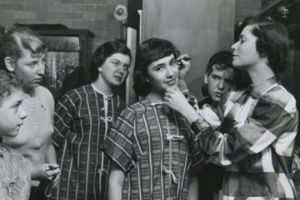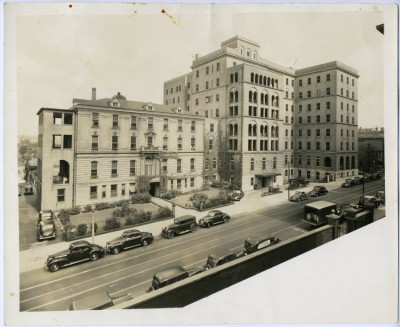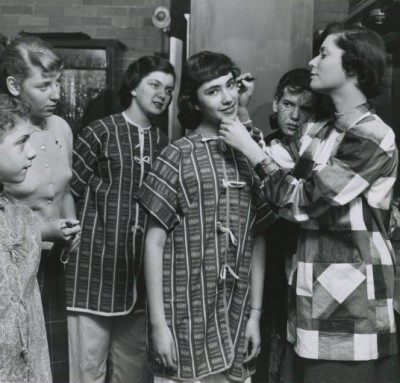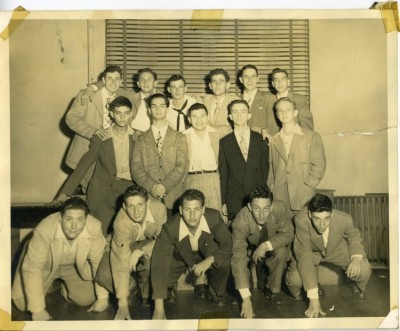Elaine, Meet Stanley

A blog post by Historian Deb Weiner.
We recently started to create a new genealogy resource: a database of Jewish babies born in Baltimore, as revealed by Jewish Times birth notices. So far, we’ve compiled around 700 names of babies born between 1928 and 1932. We’re also recording the names of the parents and the hospitals where the births occurred.

So the list can tell us some interesting things. Like, where were Jewish babies born during that time period? If you guess the obvious, Sinai Hospital, you’d be right—half the time. Around 48 percent of the babies listed in the JT were born at Sinai, then located on East Monument Street. In second place was Mercy Hospital, with 15 percent. Some 9 percent were born at the Women’s Hospital in Bolton Hill. (It later merged with another hospital to form GBMC.) In fourth place was Church Home Hospital in East Baltimore, with 8 percent. This hospital, by the way, is where Edgar Allan Poe died in 1849 after he was found, delirious, on Lombard Street between High and Exeter (later, the heart of Jewish East Baltimore). And how many were born at Johns Hopkins Hospital? One! A girl named Helen Udell. Why this particular distribution? I have no clue.
OK now to even more interesting stuff. What do you think was the most popular name for Baltimore’s Jewish baby girls from 1928 to 1932? Hint: look at the headline. Of the 367 girls whose names were listed, there were sixteen Elaines, topping the baby girl pool. In second place was Beverly, with fifteen names. I found that one hard to believe. There were eleven babies named Betty, nine named Phyllis, eight Myras, seven named Frances, Marilyn, Ruth, and Sonia. There were six Aileens, Charlottes, Harriets, Joans, Natalies, Rhodas, and Shirleys.

I was surprised there were more babies named Natalie than Barbara (four) or Hannah (three) or Bessie (two) or Susan (zero). And there were three girls named Leatrice, which I found odd, since I’ve never met one person with that name. I wasn’t surprised by the popularity of Phyllis—the name belonged to my mom (b. 1935), my dad’s sister, one of his cousins, and two of their close friends. I actually thought it would score higher.
Baby boys: Stanley led the way with thirteen out of 341 boys. Next was Howard with eleven. There were ten baby boys named Allen (or Allan), Marvin, and Richard. Nine were named David and Harold (or Harry). There were eight Bernards, Jeromes, and Roberts. Seven were named Alvin, Herbert, and Norman while six were named Arnold, Joseph, Leonard, Martin, and Samuel. There were only two Aarons, one Abraham (plus one Abram), two Benjamins, two Jacobs, one Israel, and no Isaacs. I guess the Bible had fallen out of favor during this period. Why name someone Israel or Isaac when you can name him Irving? (There were three of those, plus four Irwins, an Irvin, an Ira, and an Isadore.)

Lest you think there were more girls than boys born to Baltimore Jewish families, I should point out that birth notices for around 160 boys did not include names, while only 90 girls were unnamed. All told, there were around 500 boys and around 450 girls listed . . . I don’t know if that means that fewer girls were born, or that parents were more likely to send in birth notices for sons than for daughters.
In fact, this is not what you’d call a scientific poll—because I have no idea what percentage of the Jewish babies born during the period were listed in JT birth notices, or if a “certain kind” of family was more likely to have a birth notice than some “other kind” of family, which could skew the sample. But the results are suggestive nonetheless. By the late 1920s, the Baltimore Jewish population had become mostly Americanized, especially the young parents who were having these babies. They were the adult children of immigrants, American-raised if not born, and I think that tells you something about their choices.
We continue to work on the list—it should be interesting to see how the popular names change over time. And here’s where I need to recognize the volunteers who are doing such a great job constructing this database. Thanks to Stefan Freed, Martin Buckman, Vera Kestenberg, and Harvey Karch! (And by the way, there were six Martins, two Harveys, one Stephan, and no Veras on the list.)

1 reply on “Elaine, Meet Stanley”
Thanks for an excellent blog posting!! I have two points to add. First, I think that the generation naming these babies was definitely uneasy giving their “American born” children Biblical names. (Two anecdotes come to mind. I recall on the television show “All in the Family”, Archie Bunker “explaining” to his wife Edith how Jews are known for changing their last names to sound less Jewish — like Jacob Smith or Isaac White — to which his liberal son-in-law responded “Abe Lincoln”. Edith, after a thoughtful pause, says she never realized that Abraham Lincoln was Jewish. The other is that my wife recently met a Latino man named Irving who works at our local KosherMart kosher grocery store. When she remarked that Irving was an unusual Latino name, he told her that he is very surprised about how many Jewish men are named Irving.)
Also, and this is just a general impression I have in my own mind, I think that Hopkins Hospital was seen as the “gentile” hospital and Sinai as, of course, the Jewish one. Since they were directly across the street from each other, there was no need to go to Hopkins and therefore Jews did not.